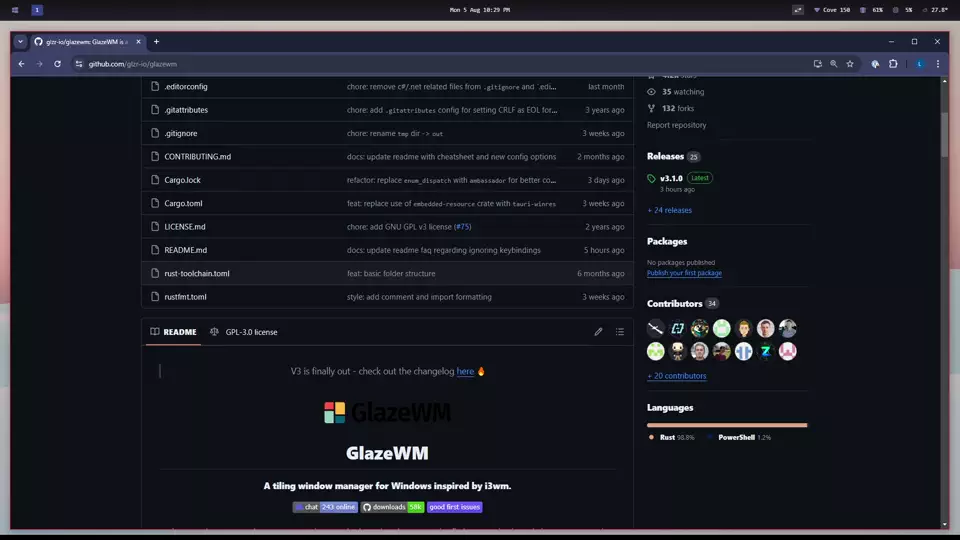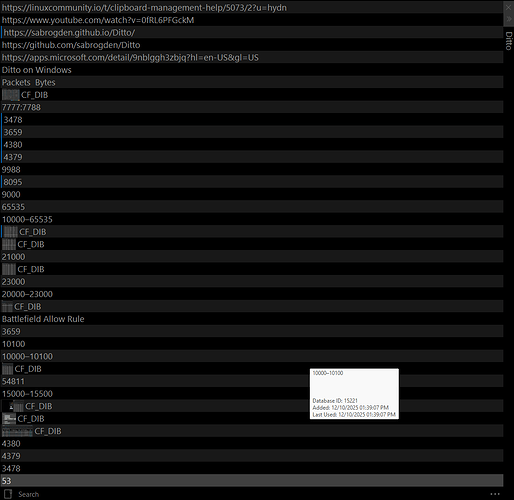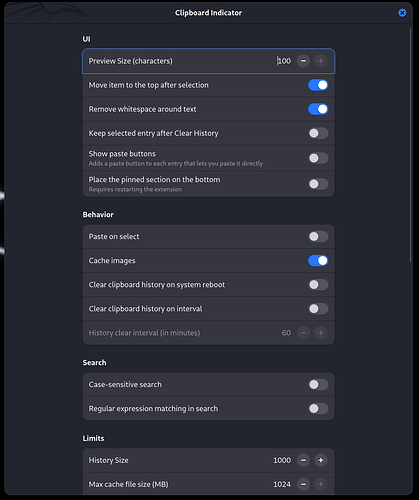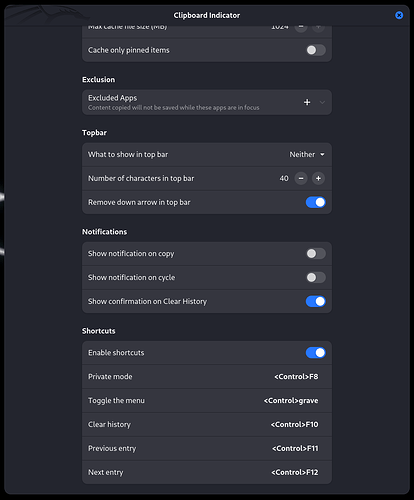About a year ago, I set up a dual-boot system to test whether Windows 11 could replace Linux as my primary work environment. I wanted to see how well Windows handled daily tasks, performance, and sysadmin tools compared to what I was used to on Linux. After a year of switching between both, I’ve learned… continue reading.
About a year ago, I set up a dual-boot system to test whether Windows 11 could replace Linux as my primary work environment. I wanted to see how well Windows handled daily tasks, performance, and sysadmin tools compared to what I was used to on Linux. After a year of switching between both, I’ve learned… continue reading.
This is a really well written article and I enjoyed reading it! I strongly resonated with several of your pain points:
- The updates “felt” so frequent and also felt out of my control. I lost hours of progress on a solo survival Minecraft world because Windows rebooted during game play, despite my settings of “Work Hours” no interruption of “full screen applications”. I also became frustrated at long time settings being changed without any input or notification to me as the user that it had happened (until I go open OBS and my audio is “wrong”). I went so far as to block Windows Updates over the network using Pi-Hole and setting up a bash download script for important updates on a Linux server so that I could gain more control, it wasn’t worth the effort in the end.
- Resource usage at idle was frustrating to me as well! I have a Ryzen 7 5800X, 32GB of RAM, and an RX 6700XT, and seeing my CPU ~10% - 15% and RAM at 20% for an “idle” system blew my mind. I knew I had more head room and I wanted to reclaim it.
- The privacy concerns and bloat were frustrating to me as well. I can, and actively do, mitigate quite a few of them with strict network control in combination with Pi-Hole + pfSense, but, it relies on me knowing what to stop and having to reverse engineer it (see point #1 about settings not sticking).
Overall, Windows is still good at several things, so I do keep a Windows 10 install on the same PC. The main reason was Destiny 2, but I really don’t play that much anymore. Now I keep it “just in case”. All the games I’ve tried (which was my biggest fear for switching over) have worked without much hassle, save for one: Star Wars Battlefront II. While I can run it, it is unstable and quite the chore. Every other game has been a breeze with similar or better performance on Linux.
I can’t see myself using Windows as a daily driver at this point unless game support takes a turn for the worse. Anyways, sorry for the long ramble! Great article!
I enjoyed the article! Personally, I’ve never been a Windows fan. Went from Atari computers to MacOS 9 to Linux. I’ve been using Linux exclusively since 2002. When I’ve been forced to use Windows for work, it’s such a confusing, inefficient mess and a chore to slog through. I’ve loved the few jobs that have allowed me to use my own computer and any OS I want, because I can do things so efficiently with it that it makes the Windows-using coworkers astonished.
Really enjoyed reading both of your perspectives. They perfectly highlight how vastly different the “Windows experience” can feel depending on how deep you go down the tweaking rabbit hole, much like Linux.
It’s interesting that we users can reach conclusions to either step away or embrace Windows (or Mac) while STILL maintaining great love for all OS’s. Of course some of us, cannot stand Windows or Mac, as do some Mac or Windows users who cannot get into using Linux.
@benowe1717 I feel you on the frustration with updates and system bloat, and @mfreeman72 I do also appreciate and personally find it easier to attain efficiency on Linux.
Regarding the fans speeds, I could come down to MSI or AMD software tweaks. As well as maybe changing power mananafement on windows from Max Performance to Balanced or power saving. However, I don’t want to do that on a gaming rig.
What’s fascinating also to me is how the story has shifted. Windows today allows far more “free” tweaking and customization than it used to, especially with the explosion of open-source tools and third-party utilities on GitHub.
In a way, modern Windows users are tailoring their setups much like Linux users have done for years it’s just happening from a different starting point and I personally find it a bit more complex. But is it because I spend more time on Linux?
Komorebi for example I found to be extremely complex to setup albeit a very capable window management tool.
In the article, the only thing I would highlight more, that my choice - just like the choice for best Linux distribution - is not an indication that Windows is the wrong choice for everyone. Only that for workflow, my preferences align best with Linux.
Here’s the thing.. The author sounded like he didn’t really use windows to begin with.. He just used windows to use all his Linux apps under WSL which really isn’t using windows to begin with.. Now if he used strictly windows tools without accessing WSL and used those tools to do his Linux work, that would have made for a better article. To say the GUI isn’t configurable enough and then using one os to emulate another really doesn’t convey anything other then if you wanna run Linux, then run Linux for Linux apps.
Hi! Thanks for your input in this article. As a brand new Linux user reading this has given me new light on what the big deal was with Linux since I’ve never used it before up until I began my journey as a software developer earlier this year. I am looking to get into cybersecurity in fact and reading the article gave me assurance to plan for a dual boot partition to really give Linux a proper try. The VirtualBox setup I have is cool and all, but my laptop struggles to stay cool due to running both systems at the same time. Then with Windows seemingly being as power hungry as it is, this article made me aware that perhaps it’s time I move forward and finish the job of dual booting Linux Mint.
Thanks for this!
Welcome @Tanithgaunt
Thanks for adding another perspective.
You are not wrong when you say that. Although, I’m not new to Windows, I’ve been using Windows desktop even before Linux. The experience was not “bad” with Windows, and thus why I was able to use it for a year. It’s just the subtle things; CPU usage (ram, I knew what to expect), maintenance/updates, complexity of tweaking and fine-tuning, etc. vs. Linux that made me switch back.
Remember also that this is 1 of 3 articles. I didn’t rehash or restate much of the first two articles.
Lastly, I’m addicted to tiling window managers and their keyboard-centric flow (instead of mouse). I have stated in previous articles that it dominates my decision making process since I cannot go back to using a non-tiling desktop. So even with Linux distros, I still customize to use i3-like tiling.
In any case, you’re not wrong that whatever OS I use now, I want it to be keyboard-centric rather than mouse-centric. But another way to look at it is, that 10 years ago, I would not have survived a year on Windows. So being able to bend Windows 10 and 11 in this way is a positive in my view, not a negative.
Also, Windows has become very customizable and open-source friendly/compatible. Tiling WMs, for example, have at least 3 to 5 solid solutions to accomplish this and many other tweaks, including using tools like Windows PowerToys.
@GC67 If you have the disk space, dual boot is the way to go, especially if there are performance concerns.
I have another viewpoint here: a neighbor had a very usable old HP ENVY x360 with Windows 10. Naturally support is gone now unless you want one of those extended enterprise support packages and are willing to pay for it. My neighbor knew nothing of this, but had heard that I liked Lenovo so they got a Lenovo Slim 3 (I believe it’s an Ideapad variant) and it had Windows 11. I unpackaged it for them and started it up.
The initial startup was good, but good old Windows already had gobs of updates. I started them but it took way too long so I cancelled them and suggested that they take the new system to the Tech Support at our site: that person was INUNDATED with people either trying to upgrade from Windows 10 to 11 or who got new computers and needed help!
So okay, it’s not all terrible; the interfaces and choices are much improved, but the updating and upgrading mechanisms are horrible compared to what I’m used to. No wonder most enterprise systems get updated OFF hours; they’d be wasting valuable time during the day to make these “updates” and “upgrades”! No thanks, at least for me.
Also, that neighbor GAVE me their HP ENVY x360; I noticed that HP also uses this model series to sell their Chromebook configuration. Instead of turning it into a Chromebook or attempting to do so, I put the light version of Linux I’ve mentioned before: antiX, on this system and it works GREAT, so for me, I wouldn’t need Windows. In the distant past I put Linux on Dell D600-630 laptops with great success. I’ve done the same with various generations of Thinkpad laptops, beginning with the EARLY T40 and T60 series, then the T400 series and I’m running a recent Thinkpad T14 Gen 3 right now - with Linux, of course!
I just realized (because I have not logged into Win 11 in a while) I didn’t include my current tiling WM solution, which is GlazeWM and Zebar:
(Click on the images to play demo)

Zebar:

Also using Ditto for clipboard history because I cannot use a PC without at least my last 200 clipboard copy history saved. (lifesaver countless times)
On Gnome I use Clipboard Indicator. There are several others, including Pano.
@hydn I’m curious about your need for at least 200 clipboard history. Is that because of the otherwise limited Windows features in this regard? I ask this because I typically use bash command history instead and it’s possible to set very large numbers for command history and I believe I’ve also had this span multiple logins.
If it actually works across logins, wouldn’t adding bash to Windows help, or alternatively, doesn’t Windows now have a PowerShell that actually has pretty good capabilities in this regard?
What else is it that you need that makes clipboard history so important to you; wouldn’t a sticky command history get you much of the same capability?
@Brian_Masinick Yes, that’s why clipboard history matters so much to me. I copy and paste constantly throughout the day: commands, credentials, URLs, screenshots (clipboard managers save all images and screenshots that I copy), config snippets, notes, you name it.
On most systems, once you copy something new, the previous item is gone. That single-item clipboard feels like working blind. I rely on my history almost like a timeline of my work. If I troubleshoot something for a client on Monday and they circle back on Friday, I can scroll through my clipboard history, see exactly what I used, when I used it, and piece everything together, modify and go again.
I use Ditto on Windows [video]. Its set to keep my last 500 copied items (including images), which basically becomes a searchable “map” of my day and week. It’s saved me more times than I can count, especially for things I didn’t expect to need again: Ditto - Clipboard Manager | Ditto
But I found Ditto because I use clipboard managers on Linux desktop long before Windows.
Bash history is great for commands, but clipboard history covers everything else, and that’s where it really shines for me.
For example, clip history while responding to this post:
Those are the port numbers I was working with on pfSense, which happened to be blocking Battlefield earlier (it’s Sunday after all ![]() ).
).
You can see where I shifted from the firewall to forum reply. All my days, including workdays, look similar, in that I can review my clipboard history to see what I’ve been working on/doing.
On Linux I’m using Clipboard Indicator here’s the settings:
Both screenshots above came from copy and pase in clipboard:
Gotcha, so it’s all the other things, especially images, that you want to be able to access; that makes sense. Thanks for the update.
Yeah, pretty much. To be fair, Windows comes with its own clipboard manager.
There are also options for Mac, like Clipboard Manager - PastePal on the App Store (probably others, but I lack experience on macOS).
Also, many managers allow you to bookmark some items that, let’s say, you know you will be pasting repeatedly for the day or week.
I like your equation to the terminal history command. I guess especially for us Linux users, we sometimes know how being able to type history and view a previous command from 500+ commands ago, can save the time/day.
Yeah, I’m mostly a terminal-based type of user. I see, especially here, that you do much more than that, often with visual illustrations and more. There’s a lot of value in that, but such things are a “learning curve” in an area that’s not a focal point for me personally, so I appreciate your work and expertise.
Great explanation of this, which also highlights a positive of the Windows ecosystem - an excellent collection of valuable tools. So this Linux geek acknowledges that different systems do have solid reasons why people use them.
It’s interesting to see someone going from Linux to Windows, instead of the other way. I use all three, Linux, Windows and MacOS, and I did a good amount of IT support for Windows. A little less for MacOS. Linux has been around 6 months for me now.
I do feel a bit like a previous commenter who said it didn’t feel like the writer wanted to use Windows that much.
Let me put it to you like this: us Windows users get told all the time that if we want to use Linux, it is not Windows and we should learn how to do things the Linux way. I embraced that, and in fact I rather like doing things the Linux way, but I also do like a certain amount of GUI. And if something requires a load of command line, I will see if I can automate it so I don’t have to write too many commands.
I never really automated much on Windows as I did not feel like I needed to, due to the GUIs.
As a side note, I think one thing people don’t get with GUIs when they hate on them for being slow, is that you don’t have to memorize a commands, and that they offer a lot of discoverability without needing to leave your desktop to look at documentation.
Anyway, going back to doing things the way the OS expects you to, us Windows people we get told that we should also consider finding equivalent software, preferably open source software, to replace our apps, or keep dual booting or a VM. It doesn’t feel like there was any effort to do that in this article, i.e., finding Windows versions (which I would have thought might be easier than trying to find Linux versions). To be fair the writer also admits he was just using his Linux software, so there was no point in Windows for him. But that IS the main reason why people don’t switch away from Windows either. They like the software they got used to.
Gaming wise the performance gap has decreased considerably especially for AMD. Nvidia still has some work, but finally they are starting to contribute to their Linux stack. The main thing is that some distros won’t give you the latest drivers, so one needs to be aware of it and update, and that isn’t always a straightforward process on Linux as it is on Windows, as it can require third party repos.
At the end of the day though, I do understand going back to Linux for the reasons the author did. I really like Linux, it’s my daily driver now. I keep a Windows install for games that won’t run on Linux due to anti-cheat, but I will play the rest on Linux.
MacOS I use for work, it’s actually the OS I am less keen on from a UI point of view. Mostly I hate the window management.
I don’t completely hate Windows and there are so many changes to the past several versions of Windows that we can now use many vastly improved tools. I was really happy when the Power Shell became available. Cygwin tools also make many Unix-like programs available and editors like Notepad++ and UltraEdit mean you can get very nice tools too.
While I can still find faster Linux alternatives the average full featured Linux system isn’t that much more efficient. What’s different is that Windows is not really free, though it’s bundled into most hardware purchases.
I still prefer Linux but it amounts to personal preference.
I can definitely understand your perspective. The improvements in Windows, like PowerShell and the availability of Unix-like tools, have made it much more versatile, especially for users who need a hybrid environment. I agree that it’s not as free as Linux, but it’s a trade-off for the convenience of having so many pre-installed tools and broader software compatibility.
I personally still lean toward Linux for its customization and open-source nature, but like you said, it often comes down to personal preference. Windows has definitely gotten better, though, especially with how much more flexible it’s become over the years.


